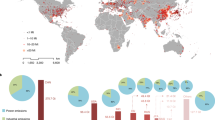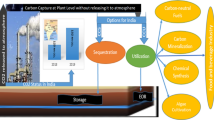Abstract
In China, carbon capture and storage (CCS) is recognized as one of the most promising technologies through which to achieve a large reduction in CO2 emissions in future. The choice among different CCS technologies is critical for large-scale applications. With the aim of developing instructive policy suggestions for CCS development, this study proposed an interval programming model to select the optimal CCS technology among the different CCS technologies available in China. The analysis results indicate that the selection of CO2 capture technologies should be based on the actual situation of the project and industry being targeted. If the government implements mandatory CO2 emission reductions, storage in deep saline aquifers is the optimal choice for CO2 sequestration when oil prices are low and the number of available CO2 emission permits is large. In contrast, enhanced oil recovery is the optimal choice when oil prices increase and the availability of CO2 emission permits decreases. It is critical that the government reduce the operating cost and the cost of CO2 capture in particular.





Similar content being viewed by others
References
Aaron D, Tsouris C (2005) Separation of CO2 from flue gas: a review. Sep Sci Technol 40(1–3):321–348
Alarcon-Rodriguez A, Ault G, Galloway S (2010) Multi-objective planning of distributed energy resources: a review of the state-of-the-art. Renew Sustain Energy Rev 14(5):1353–1366
Audus H (2000, August) Leading options for the capture of CO2 at power stations. In: Proceedings of the fifth international conference on greenhouse gas control technologies, Cairns, Australia
Bakken BH, von Streng Velken I (2008) Linear models for optimization of infrastructure for CO2 capture and storage. IEEE Trans Energy Convers 23(3):824–833
Blomen E, Hendriks C, Neele F (2009) Capture technologies: improvements and promising developments. Energy Procedia 1(1):1505–1512
Bougie F, Iliuta MC (2011) CO2 absorption in aqueous piperazine solutions: experimental study and modeling. J Chem Eng Data 56(4):1547–1554
Chandel MK, Pratson LF, Williams E (2010) Potential economies of scale in CO2 transport through use of a trunk pipeline. Energy Convers Manag 51(12):2825–2834
Chen TY (2001) The impact of mitigating CO2 emissions on Taiwan’s economy. Energy Econ 23(2):141–151
Chen W, Le Nindre YM, Xu R, Allier D, Teng F, Domptail K, Zeng R (2010) CCS scenarios optimization by spatial multi-criteria analysis: application to multiple source sink matching in Hebei Province. Int J Greenh Gas Control 4(2):341–350
Chiaramonte L, Zoback M, Friedmann J, Stamp V, Zahm C (2011) Fracture characterization and fluid flow simulation with geomechanical constraints for a CO2–EOR and sequestration project Teapot Dome oil field, Wyoming, USA. Energy Procedia 4:3973–3980
Cristóbal J, Guillén-Gosálbez G, Jiménez L, Irabien A (2012) Optimization of global and local pollution control in electricity production from coal burning. Appl Energy 92:369–378
Diakaki C, Grigoroudis E, Kolokotsa D (2008) Towards a multi-objective optimization approach for improving energy efficiency in buildings. Energy Build 40(9):1747–1754
Diakaki C, Grigoroudis E, Kabelis N, Kolokotsa D, Kalaitzakis K, Stavrakakis G (2010) A multi-objective decision model for the improvement of energy efficiency in buildings. Energy 35(12):5483–5496
Fells I, Woolhouse L (1994) A response to the UK national programme for CO2 emissions. Energy policy 22(8):666–684
Gale J, Davison J (2004) Transmission of CO2-safety and economic considerations. Energy 29(9):1319–1328
Gielen D (2003, May) The energy policy consequences of future CO2 capture and sequestration technologies. In: Proceedings of the 2nd annual conference on carbon sequestration. Alexandria, VA
Hall-Spencer JM, Rodolfo-Metalpa R, Martin S, Ransome E, Fine M, Turner SM, Rowley SJ, Tedesco D, Buia MC (2008) Volcanic carbon dioxide vents show ecosystem effects of ocean acidification. Nature 454(7200):96–99
Han JH, Lee IB (2011) Development of a scalable and comprehensive infrastructure model for carbon dioxide utilization and disposal. Ind Eng Chem Res 50(10):6297–6315
Hu Z, Tan P, Pu G (2006) Multi-objective optimization of cassava-based fuel ethanol used as an alternative automotive fuel in Guangxi, China. Appl Energy 83(8):819–840
Huang GH, Baetz BW, Patry GG (1992) A grey linear programming approach for municipal solid waste management planning under uncertainty. Civ Eng Syst 9(4):319–335
Huang GH, Baetz BW, Patry GG (1993) A grey fuzzy linear programming approach for municipal solid waste management planning under uncertainty. Civ Eng Syst 10(2):123–146
IEA (2011) World Energy Outlook. Int Energy Agency, Paris
Johnsen K, Helle K, Røneid S, Holt H (2011) DNV recommended practice: design and operation of CO2 pipelines. Energy Procedia 4:3032–3039
Koroneos C, Michailidis M, Moussiopoulos N (2004) Multi-objective optimization in energy systems: the case study of Lesvos Island, Greece. Renew Sustain Energy Rev 8(1):91–100
Li GC, Huang GH, Lin QG, Zhang XD, Tan Q, Chen YM (2011) Development of a GHG-mitigation oriented inexact dynamic model for regional energy system management. Energy 36(5):3388–3398
Lie JA, Vassbotn T, Hägg MB, Grainger D, Kim TJ, Mejdell T (2007) Optimization of a membrane process for CO2 capture in the steelmaking industry. Int J Greenh Gas Control 1(3):309–317
Manne AS, Richels RG (1991) Global CO2 emission reductions: the impacts of rising energy costs. Energy J 12(1):87–107
Mavrotas G, Diakoulaki D, Papayannakis L (1999) An energy planning approach based on mixed 0–1 multiple objective linear programming. Int Trans Operat Res 6(2):231–244
McKinsey Climate Change Initiative (2008) Carbon capture and storage: assessing the economics. McKinsey and Company, New York City
Michael K, Golab A, Shulakova V, Ennis-King J, Allinson G, Sharma S, Aiken T (2010) Geological storage of CO2 in saline aquifers—a review of the experience from existing storage operations. Int J Greenh Gas Control 4(4):659–667
Middleton RS, Bielicki JM (2009a) A comprehensive carbon capture and storage infrastructure model. Energy Procedia 1(1):1611–1616
Middleton RS, Bielicki JM (2009b) A scalable infrastructure model for carbon capture and storage: SimCCS. Energy Policy 37(3):1052–1060
Middleton RS, Kuby MJ, Bielicki JM (2012) Generating candidate networks for optimization: the CO2 capture and storage optimization problem. Comput Environ Urban Syst 36(1):18–29
Ordorica-Garcia G, Elkamel A, Douglas PL, Croiset E, Gupta M (2008) Energy optimization model with CO2-emission constraints for the Canadian oil sands industry. Energy Fuels 22(4):2660–2670
Pfaff I, Kather A (2009) Comparative thermodynamic analysis and integration issues of CCS steam power plants based on oxy-combustion with cryogenic or membrane based air separation. Energy Procedia 1(1):495–502
Ren H, Zhou W, Nakagami KI, Gao W, Wu Q (2010) Multi-objective optimization for the operation of distributed energy systems considering economic and environmental aspects. Appl Energy 87(12):3642–3651
Rose A, Stevens B (1993) The efficiency and equity of marketable permits for CO2 emissions. Resour Energy Econ 15(1):117–146
Rubin ES, Chen C, Rao AB (2007) Cost and performance of fossil fuel power plants with CO2 capture and storage. Energy policy 35(9):4444–4454
Svensson R, Odenberger M, Johnsson F, Strömberg L (2004) Transportation systems for CO2—application to carbon capture and storage. Energy Convers Manag 45(15):2343–2353
Szulczewski ML, MacMinn CW, Juanes R (2014) Theoretical analysis of how pressure buildup and CO2 migration can both constrain storage capacity in deep saline aquifers. Int J Greenh Gas Control 23:113–118
Tsay MT (2003) Applying the multi-objective approach for operation strategy of cogeneration systems under environmental constraints. Int J Electr Power Energy Syst 25(3):219–226
van den Broek M, Ramírez A, Groenenberg H, Neele F, Viebahn P, Turkenburg W, Faaij A (2010) Feasibility of storing CO2 in the Utsira formation as part of a long term Dutch CCS strategy: an evaluation based on a GIS/MARKAL toolbox. Int J Greenh Gas Control 4(2):351–366
van der Zwaan B, Smekens K (2009) CO2 capture and storage with leakage in an energy-climate model. Environ Model Assess 14(2):135–148
Vilarrasa V, Bolster D, Olivella S, Carrera J (2010) Coupled hydromechanical modeling of CO2 sequestration in deep saline aquifers. Int J Greenh Gas Control 4(6):910–919
Yu S, Zhang J, Cheng J (2016) Carbon reduction cost estimating of Chinese coal-fired power generation units: a perspective from national energy consumption standard. J Clean Prod 139:612–621
Zhang YJ, Hao JF (2015) The allocation of carbon emission intensity reduction target by 2020 among provinces in China. Nat Hazards 79(2):921–937
Zhang X, Duncan IJ, Huang G, Li G (2014) Identification of management strategies for CO2 capture and sequestration under uncertainty through inexact modeling. Appl Energy 113:310–317
Zhang YJ, Hao JF, Song J (2016) The CO2 emission efficiency, reduction potential and spatial clustering in China’s industry: evidence from the regional level. Appl Energy 174:213–223
Zhu Y, Huang GH, Li YP, He L, Zhang XX (2011) An interval full-infinite mixed-integer programming method for planning municipal energy systems–a case study of Beijing. Appl Energy 88(8):2846–2862
Acknowledgements
The authors gratefully acknowledge the financial support from the National Natural Science Foundation of China (Nos. 71020107026, 71401010, 71402103), the China Postdoctoral Science Foundation (Nos. 2015T80041, 2015M580053 and 2016T90042), the National Key Research and Development Program of China (2016YFA0602801), and Joint Development Program of Beijing Municipal Commission of Education.
Author information
Authors and Affiliations
Corresponding author
Rights and permissions
About this article
Cite this article
Li, H., Qin, Q. Optimal selection of different CCS technologies under CO2 reduction targets. Nat Hazards 88, 1197–1209 (2017). https://doi.org/10.1007/s11069-017-2914-3
Received:
Accepted:
Published:
Issue Date:
DOI: https://doi.org/10.1007/s11069-017-2914-3




